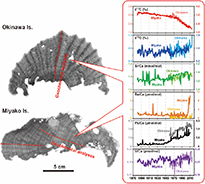** Progress in Earth and Planetary Science is the official journal of the Japan Geoscience Union, published in collaboration with its 50 society members.
Gallery View of PEPS Articles
Research
Biogeosciences
202106202106
Reconstruction of ocean environment time series since the late nineteenth century using sclerosponge geochemistry in the northwestern subtropical Pacific
R. Asami, T. Matsumori, R. Shinjo, R. Uemura, Y. Miyaoka, M. Mizuyama, Y. Ise, T. Sakamaki
Sclerosponge, Acanthochaetetes wellsi, Oxygen and carbon isotopic composition, Minor and trace elements, Isotope equilibrium, Paleoenvironmental proxy, Ryukyu Islands
Underwater photo of a living Acanthochaetetes wellsi sclerosponge examined in this study (upper), X-radiographic positive images of sclerosponges (bottom left), and the near-annual resolved geochemical time series since 1880 (bottom right).
The geochemistry of calcifying marine organisms is an excellent proxy for reconstructing paleoceanographic history, but studies of hypercalcified demosponges (sclerosponges) are considerably fewer than those of corals, foraminifers, and bivalves. For this study, we first generated near-annual resolved stable carbon and oxygen isotope (δ13C and δ18O) and element/Ca ratios (Sr/Ca, Ba/Ca, Pb/Ca, U/Ca) time series for 1880–2015 from sclerosponge samples (Acanthochaetetes wellsi) collected at Miyako Island and Okinawa Island in the Ryukyu Islands of southwestern Japan. The δ13C records exhibited a typical variation of anthropogenically derived Suess effects, demonstrating that the rates of decrease of –0.0043‰/year before 1960 and – 0.024‰/year after 1960 in the northwestern subtropical Pacific were respectively similar to and about 1.4 times higher than those of the Caribbean Sea in the tropical Atlantic. Spectral analysis of the δ18O time series revealed significant periodicity of approximately 2, 3, 6.5, 7–10, and 20–30 year/cycle, indicating that sea surface conditions in the southern Ryukyu Islands had been dominated by interannual and decadal variations in temperature and seawater δ18O since the late nineteenth century. The Sr/Ca and U/Ca ratios for the species A. wellsi (high-Mg calcite) might not be a robust proxy for seawater temperatures, unlike Astrosclera willeyana and Ceratoporella nicholsoni sclerosponges (aragonite). An evident increasing Pb/Ca trend after 1950 found in the samples is probably attributable to Pb emissions from industrial activities and atmospheric aerosols in eastern Asian countries. The Ba/Ca variations differ greatly among sampling sites, which might be attributable to the respective local environments. This evidence demonstrates that more high-resolution age determinations and geochemical profilings enable delineation of secular variations in ocean environments on annual and interannual timescales. Results of our study suggest that if sclerosponges living in deeper ocean environments are collected, spatial and vertical oceanographic variations for the last several centuries will be reconstructed along with coral proxy records.







